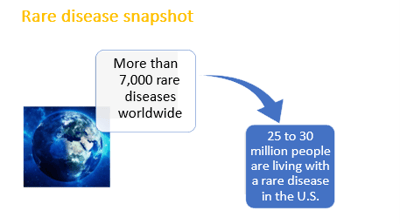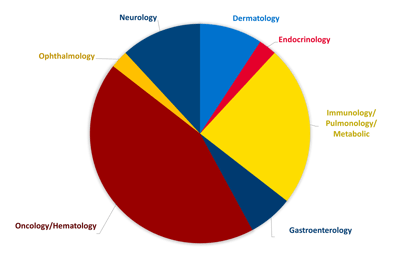Although rare diseases are rare individually, there are approximately 7,000 of them. According to Genetic and Rare Diseases Informational Center (GARD) there are 25-30 million people who have rare diseases in the USA. This means that about 1 in every 10 people have a rare disease.

Because of the low prevalence of each rare disease, they are difficult to diagnose, and treatment remains challenging. Many of these diseases are severe, quickly progressing, debilitating, and involve life-long suffering. On average, it takes approximately 5-7 years to receive an accurate diagnosis of a rare disease. Most rare diseases are genetic or have a genetic component and 75% of rare diseases are without a single FDA-approved treatment. Many rare disease patients have few or no options when it comes to effective treatment of their symptoms. Even when medications with confirmed effectiveness are prescribed, they often are used without FDA approval (a practice known as off-label use), which sometimes makes it difficult to get insurance to cover the cost. This great unmet need makes it imperative that we find ways to accelerate the therapy development process so that we can help the many patients and families who are in search of better treatments.
For this reason, the principles of Good Clinical Practice (GCP) and Food and Drug Administration (FDA) regulations ask for adequate and on-time responses which will prevent as many fatal consequences as possible. Nowadays bio-pharmaceutical companies working on orphan drugs have more than 800 projects in clinical development. Our experience as a CRO has shown the exceptional interest in developing new drugs for rare diseases across many therapeutic areas. Recently, Linical has been involved in nearly 70 trials for innovative drugs for various rare diseases. The pie chart below shows the therapeutic areas of rare pathologies we worked with.

Rare Disease Research Challenges
Clinical trials are critical to developing and evaluating new treatments for rare diseases. For those who live with rare diseases, though, clinical drug trials have a more direct impact on their day-to-day lives. But of course, there are some of the challenges in rare diseases research.
One such challenge is high development cost and production of a new drug. As we mentioned above, most rare diseases are genetic or have a genetic component, and there are often high manufacturing costs for innovative technologies, such as gene therapy approaches. High clinical development costs are particularly difficult for rare diseases to overcome because the market for the product, once approved, is inherently small, thus limiting the potential for return-on-investment. It is important to keep in mind that the infrastructure in research in rare disease needed for clinical studies is too often established de novo for each disease and clinical development program, making it a costly enterprise, especially when the expense is considered per research participant. One approach is therefore building and sharing research infrastructures with the use of national and international research networks that can take on therapy development. Nowadays there are several of them collaborating very successfully to improve the process of developing new drugs for rare diseases.
For patients, clinical trials are an opportunity to receive promising new therapies; however, the enrollment process can often be overwhelming to navigate. Recruitment of enough suitable patients to obtain meaningful results is a major challenge. The patients are scattered throughout the country, or the world, and sometimes they are not even correctly diagnosed.
With conditions like diabetes or arterial hypertension, for example, you could have thousands of patients. In rare diseases, you would have a much smaller number, because there might be less than 30 cases of the condition, worldwide. You have to work out the statistics to make sure you have the right amount of data over the right amount of time to get the study to be statistically significant, enabling the drug to be approved.
Another enrollment challenge is that fewer patients seem willing to participate in clinical studies for rare diseases. Some driving factors behind this are the inability of individuals to cover all out-of-pocket travel expenses (patients often have to travel across long distances to reach a trial site), and their condition may make travel challenging. The other factor that prevents patients from taking part in a study is the fact that it is too time-consuming, as well as the fear of participating in a new drug trial.
Another big difficulty for rare disease research is whether positive results can be delivered in a short period of time, since clinical trials for rare diseases can take years. This puts at risk a huge number of people all around the world. With not enough suitable patients, the task becomes increasingly difficult to produce an efficient drug in a short period of time.
Innovative Approaches and Solutions for Rare Disease Studies
The whole process can be speeded up when more people take part in studies which are focused on rare diseases. Right now, it is difficult for a patient to always know the available options, and it is very difficult to know which trial might be most promising. It is important to have greater transparency around the clinical trial landscape for a specific condition and to support patients and providers in making informed decisions around trial participation. This approach is called patient-centricity.
To deal with these obstacles, researchers and sponsors seek different and more convenient solutions like organizing in-house trials using mobile technology or wearable biosensors to complete some trial visits remotely. Our experience has shown that the hybrid clinical strategy (a mix of traditional onsite clinic visits with offsite telehealth visits or some variation thereof), is a very effective strategy in providing these patient populations with access to clinical research for rare diseases when in the past, this may not have been possible. Furthermore, executing strategies to provide a centralized screening and recruiting effort and then referring qualified study participants to a nearby investigator close to their home or other alternatively desired location, is very convenient for patients, increasing their compliance for study participation.
The other solution to increase the quality and timing of rare disease trials is contacting patient support groups. Since these groups keep patient registers, recruiters and research experts are better able to find information about the location of specific subjects, their health conditions, biological sample data, and genetics. Usually, these groups are very strong in promoting patient education and explaining the opportunities and safety considerations of participating in clinical trials. Furthermore, contacting such groups can also help sites to cover bigger geographical areas and to discover other treatment centers and research specialists who could provide further assistance in a clinical study. We have been most successful in such trials when we involve the patient organizations from the onset of the trial, as well as having them participate in ongoing meetings.
Conducting clinical studies in the rare disease space to find safe and effective solutions is a collaborative effort by stakeholders in the clinical research industry including patients, patient advocates, product developers, and medical research professionals. Technological and sociocultural innovation, including better approaches to bring the trial to the patient, all play a key role in advancing rare disease research.
Author:
Diana Davydov, MD
Associate Medical Director - Linical
.jpg)